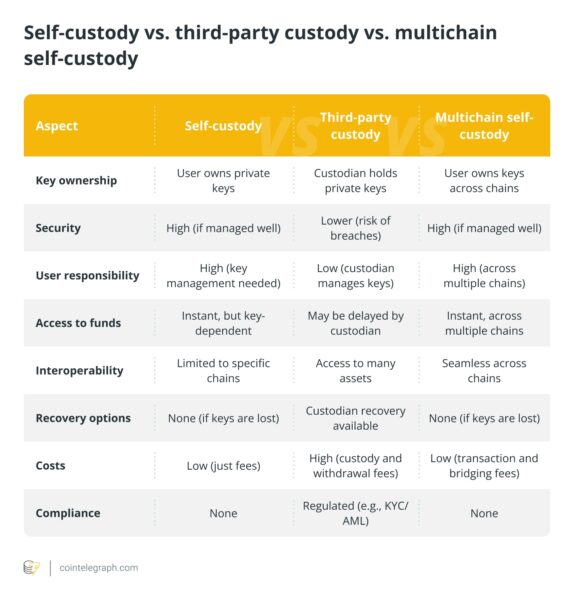What is multichain self-custody?
Multichain self-custody refers to the practice of managing digital assets across multiple blockchain ecosystems without relying on third-party custodians.
It combines the concept of self-custody — direct control of cryptocurrency assets through private key ownership — with the ability to interact seamlessly across diverse blockchain networks like Ethereum Virtual Machine (EVM), Solana Virtual Machine (SVM) and newer ecosystems such as Aptos and Sui.
By leveraging multichain wallets or decentralized tools, users can consolidate asset management into a single interface, reducing complexity.
However, this concept contrasts with third-party custody, where a centralized entity holds and manages a user’s private keys on their behalf. Private keys are critical to accessing and transferring cryptocurrencies.
In a self-custody setup, they are stored securely by the user in hardware wallets, software wallets or other secure methods. Examples of self-custody wallets include Ledger, Trezor and MetaMask, among others.
Multichain self-custody is particularly important as decentralized finance (DeFi), non-fungible tokens (NFTs) and crosschain protocols grow in popularity, requiring users to manage assets across a variety of blockchain platforms efficiently and securely.
Self-custody vs. third-party custody
Self-custody ensures users retain full ownership of their assets, protecting them from the risks of centralized control, such as platform insolvency, regulatory seizures or hacks targeting custodians.
The distinction between self-custody and third-party custody is essential because it determines who has ultimate control over the assets.
Self-custody eliminates counterparty risks, yet there are other risks. Around 3 million–4 million Bitcoin has been lost due to forgotten private keys.
While self-custody eliminates risks associated with third-party mismanagement, it places the burden of securing private keys entirely on the user. Losing access to private keys results in the permanent loss of assets. Third-party custodians may impose restrictions or fees and can lack transparency regarding how assets are managed. Self-custody provides clarity and full autonomy in decision-making.
The catastrophic collapses of the centralized exchanges FTX, Celsius and BlockFi in 2022 have heightened awareness of the risks inherent to third-party custody, driving more users toward self-custody solutions.

The rise of multichain ecosystems
A multichain future envisions a blockchain ecosystem where multiple independent chains coexist, interact and enable seamless asset and data transfer.
Unlike the earlier belief in a “winner-takes-all” blockchain landscape, where one dominant blockchain was expected to outcompete and replace others, a multichain future embraces the coexistence of multiple blockchains, each serving unique purposes.
Here are some key blockchain ecosystems shaping this multichain reality:
- Ethereum and EVM-compatible chains like BNB Smart Chain, Avalanche and Polygon are the incumbent blockchain ecosystems.
- Rust-based chains like Solana and SVM-compatible chains are known for their speed, scalability and low transaction frictions.
- Emerging blockchains like Aptos and Sui are based on the Move programming language.
A multichain ecosystem is relevant because different blockchains excel at distinct use cases, such as DeFi, NFTs or supply chain tracking. Supporting interoperability and crosschain functionality can unlock significant potential for broader adoption and innovation.
Several trends and data points suggest a multichain future is unfolding.
- The rise of non-Ethereum layer-1 blockchains such as Solana, Polkadot and Avalanche indicates user demand for alternatives that address Ethereum’s scalability issues.
- The growing adoption of crosschain bridge technologies like Wormhole, LayerZero and Axelar demonstrates an increasing need for interoperability.
- Data shows significant total value locked (TVL) of $121 billion across multiple chains, not just Ethereum, reflecting a diversification of DeFi activity.
- Chains like Solana and Polygon have gained traction in the NFT space, creating ecosystems independent of Ethereum’s dominance.
- Aptos and Sui are gaining attention for their scalability and security, attracting developers and investors alike.
- The Base chain that is backed by Coinbase has seen tremendous growth through 2024. Base, along with Solana, has contributed to the rise of memecoins’ market cap of $106 billion.
These indicators reflect the market’s appetite for diverse blockchain ecosystems and the tools to connect them. Therefore, users will need to have seamless interactions and asset mobilization capabilities across these chains.
Did you know? In 2022, Wormhole suffered a $321-million hack, exposing the risks of bridging assets across different networks. Similarly, vulnerabilities in LayerZero’s protocol have raised concerns about potential exploits, as it acts as a universal messaging layer connecting different chains.
How Multichain wallets enable self-custody in a decentralized ecosystem
As multichain interactions become increasingly common, wallets will evolve to support assets and applications across various ecosystems. Examples of multichain wallets include MetaMask, Phantom and Exodus.
The competition among wallets to provide seamless multichain functionality highlights the growing importance of user experience in a multichain world and helps drive self-custody as the primary way assets are managed. In a multichain environment, self-custody becomes even more critical as users manage assets across diverse blockchain ecosystems.
Here’s how self-custody aligns with the needs of a multichain environment:
- Users often need to bridge assets or interact with decentralized applications (DApps) on different chains. Self-custody wallets simplify this process while maintaining control.
- Managing assets across multiple blockchains can increase exposure to risks such as bridge exploits. Self-custody minimizes reliance on centralized intermediaries.
- Self-custody empowers users to manage their assets independently, free from centralized control, ensuring financial sovereignty.
Multichain wallets enable users to manage assets across ecosystems under a single interface while retaining self-custody, which ensures assets cannot be frozen or seized by third parties, maintaining financial sovereignty.
Recent developments in multichain self-custody
Multichain wallets have experienced significant advancements in 2024, enhancing user experiences and expanding blockchain support.
Here’s an overview of notable developments:
- Trust Wallet has expanded its support to over 100 blockchains, solidifying its position as a leading multichain wallet. This extensive support enables users to manage a diverse range of digital assets within a single platform.
- UXUY has integrated its wallet services into Telegram, allowing users to manage their crypto assets directly within the messaging app. This integration aims to streamline the user experience by combining social interaction with financial management.
- OKX Wallet has enhanced its multichain capabilities, enabling users to access and manage assets across various blockchains seamlessly.
- SafePal offers a hardware wallet that supports multiple chains, providing users with a secure method to store and manage their digital assets offline. This solution caters to security-conscious users seeking to protect their investments from cyber threats.
- MathWallet has developed a comprehensive multichain ecosystem, supporting numerous blockchains and offering features such as crosschain token exchanges and DApp access.
- Phantom, initially a Solana-focused wallet, has expanded its support to include Ethereum, Bitcoin, Sui and Polygon, enabling users to manage assets across these blockchains. Phantom was also ranked as one of the top seven free apps on the Apple Store in November 2024 and boasts a user base of over 7 million.
- Backpack is a minimalistic, multichain wallet available for Solana, Ethereum and Arbitrum. It offers features such as xNFTs, which are decentralized applications operating within the wallet, and NFT collection locking for enhanced security.
Risks associated with multichain self-custody
Multichain self-custody involves risks such as key loss, security vulnerabilities, user error, lack of insurance and exposure to bridge exploits.
Let’s understand these risks in a bit more detail:
- Losing private keys means losing access to assets permanently. Managing keys securely requires significant diligence.
- Self-custody can be challenging for non-technical users, increasing the likelihood of mistakes like phishing attacks or incorrect transfers.
- Bridging assets between chains can expose users to vulnerabilities in bridge protocols, requiring extra caution.
- Unlike custodial solutions, self-custody offers no fallback for lost assets, emphasizing the importance of user education.
- While regulated custodians offer insurance for at least part of the asset holdings, self-custody insurance products are not common.
Did you know? In March 2022, hackers exploited the Ronin Bridge, which connects the Ronin Network to Ethereum, stealing over $600 million in assets. The breach occurred due to compromised private keys, highlighting the risks associated with bridging assets between different blockchains.
Alternatives to self-custody
For users who find self-custody too complex or risky, alternatives exist in the form of third-party custody solutions.
These options cater to both retail and institutional users, offering varying levels of convenience, security and control. Exchanges like Coinbase, Binance and Kraken provide custody services where users’ private keys are managed by the exchanges.
These exchanges are the most common alternative for retail users. User-friendly interfaces and simplified asset management make this a lot more seamless for those who do not want to manage their private keys.
Many custodians provide insurance coverage for the assets and offer services such as trading, staking and lending. However, users are exposed to counterparty risks and need to depend on the exchange’s solvency and security practices.
Some firms also provide professional custody services designed for institutional investors, offering advanced security measures and regulatory compliance. While such providers have high security and regulatory and customer protection standards, they are more expensive and may not be suitable for smaller investors.
The rise of multichain wallets is easing the complexity of managing assets across ecosystems, bringing the vision of a multichain world closer to reality. As this landscape matures, understanding and embracing self-custody will be crucial for anyone seeking to navigate the decentralized world with confidence and security.
Source: https://cointelegraph.com/explained/what-is-multichain-self-custody-and-why-does-it-matter



